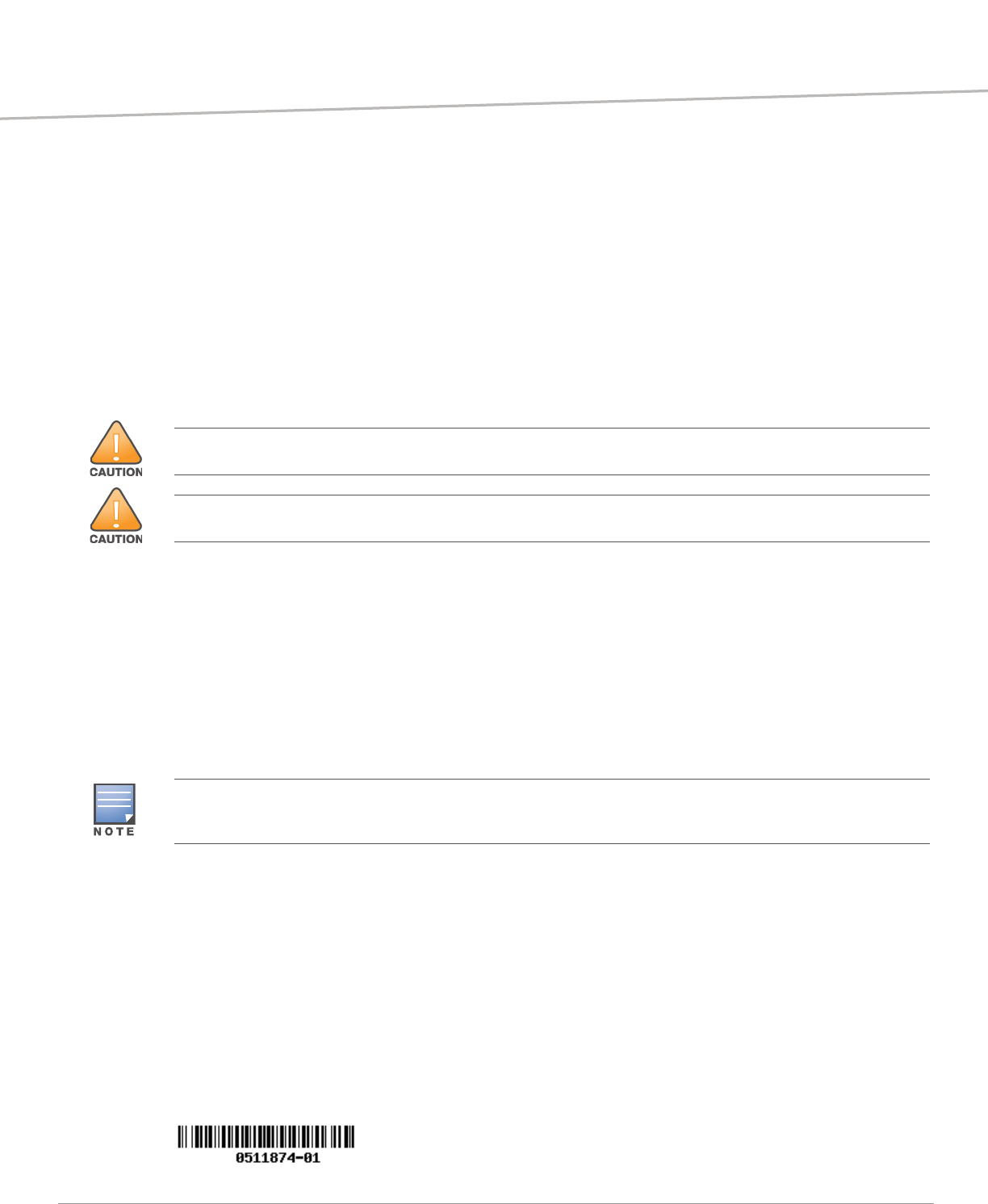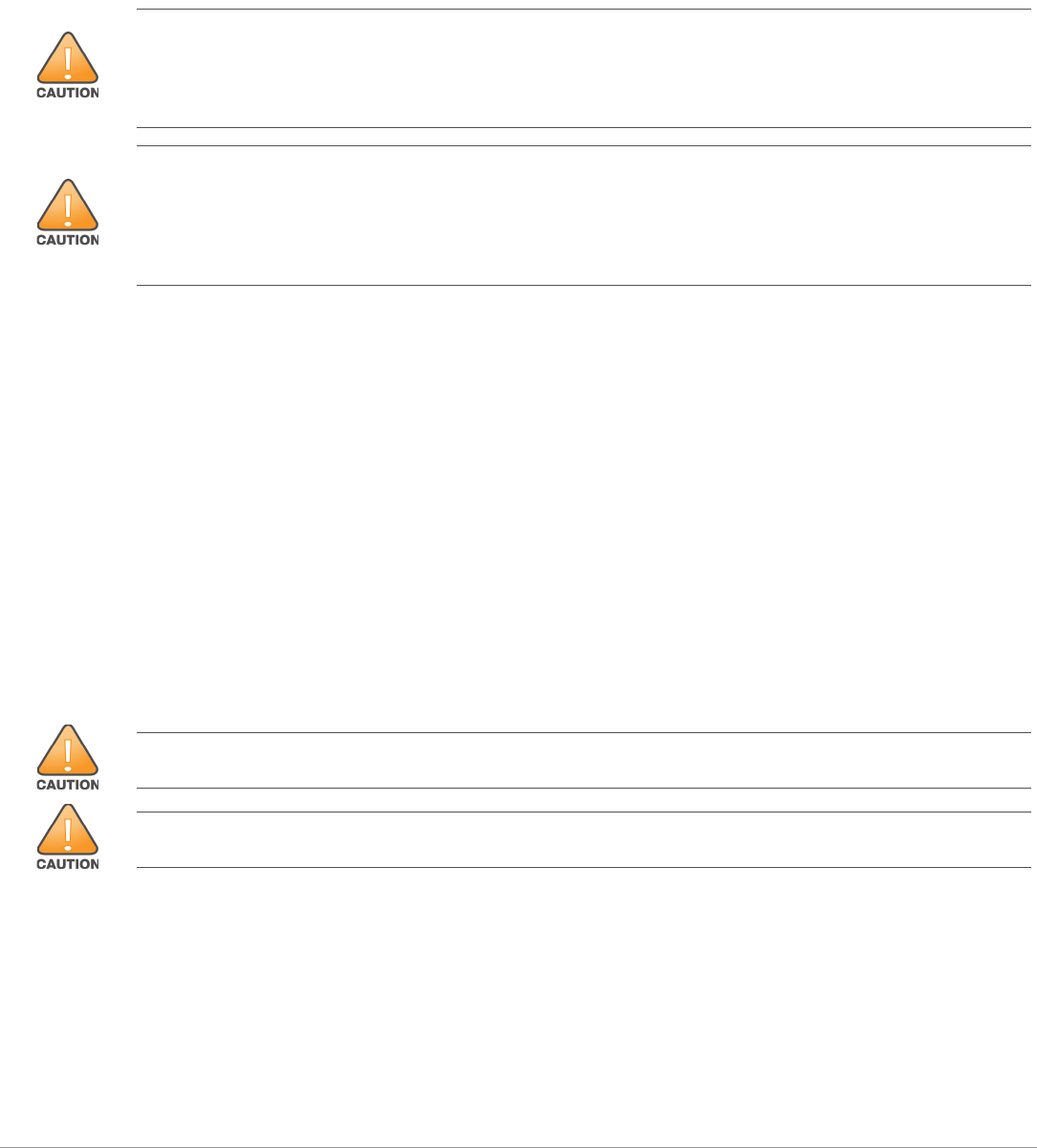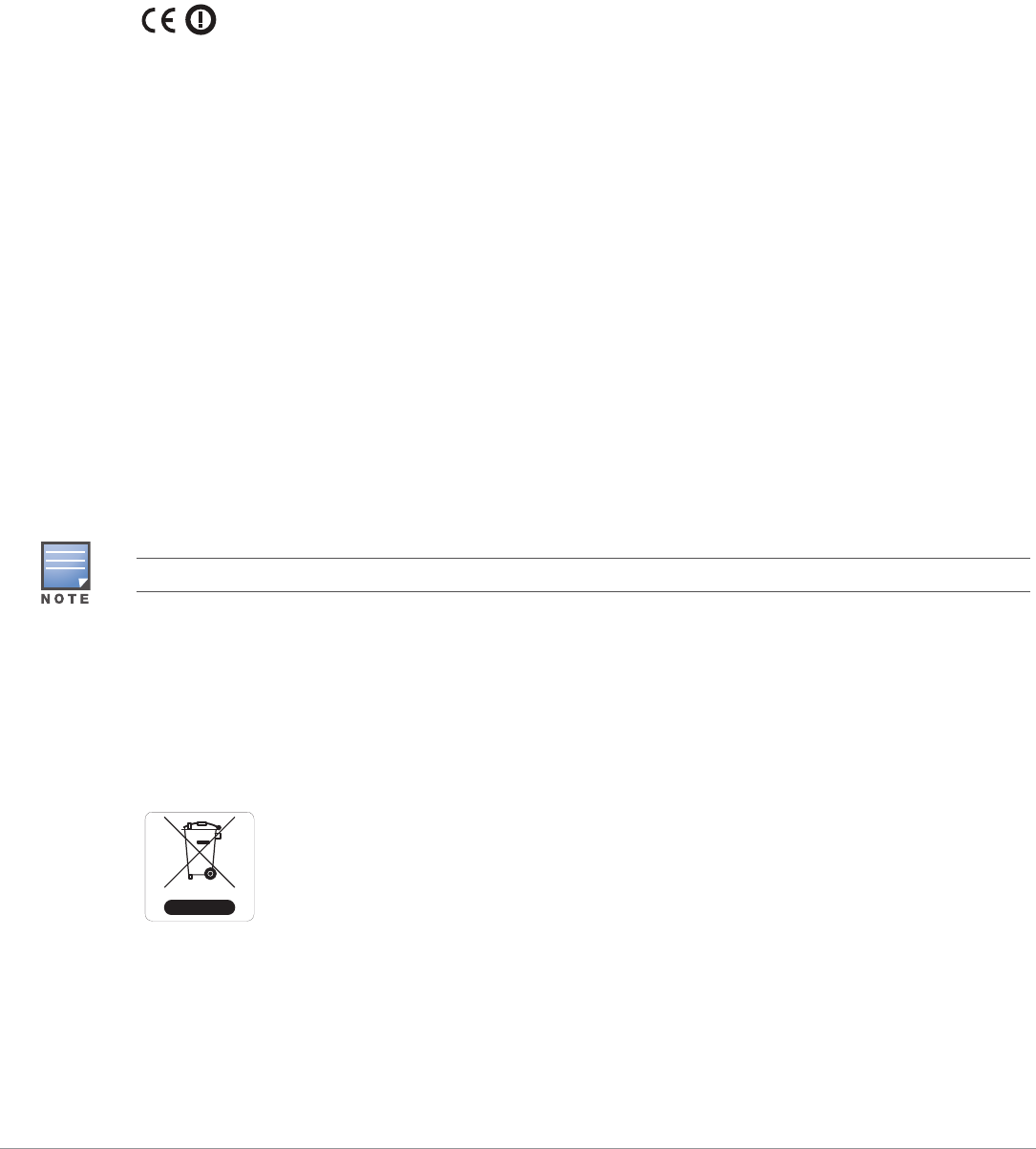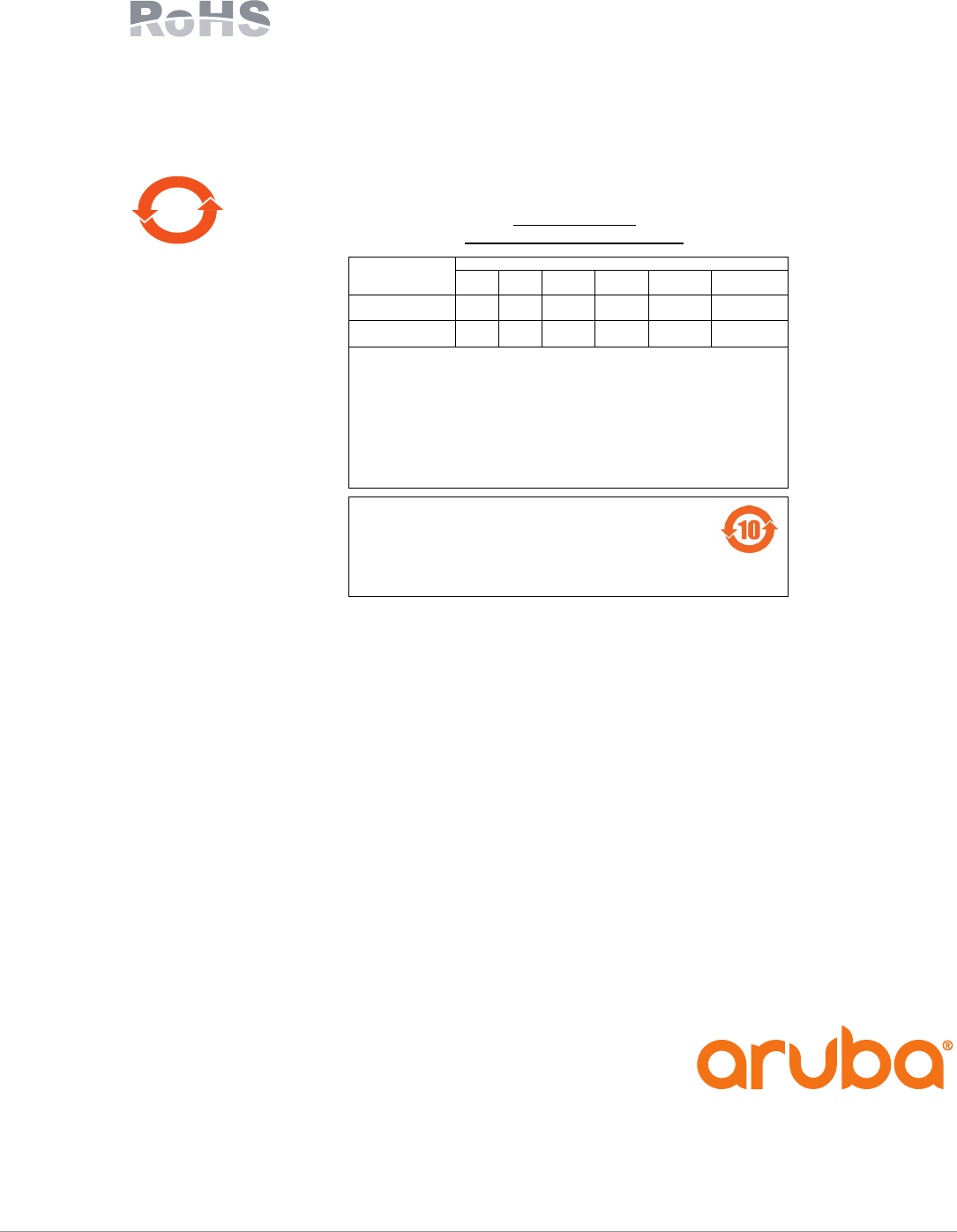Hewlett Packard Enterprise APIN0334335 Aruba 330 Series Wireless Access Point User Manual 0511874 01 xAP 330 RCSI
Aruba Networks, Inc. Aruba 330 Series Wireless Access Point 0511874 01 xAP 330 RCSI
Contents
- 1. User Manual pt 1
- 2. User Manual pt 2
User Manual pt 1

Aruba 330 Series Wireless Access Point
Regulatory Compliance and Safety Information Guide
0511874-01 | March 2016 1
Introduction
This document contains domestic and international regulatory compliance and safety information for 330 Series access points.
To ensure that this device complies with the regulatory standards for your region, please refer to the sections below.
Electrical and Environmental Specifications
Regulatory Information
Proper Disposal of Aruba Equipment
Electrical and Environmental Specifications
For additional specifications on this product, please refer to the product data sheet at www.arubanetworks.com/
safety_addendum.
Electrical
Ethernet:
ENET0: 100/1000/2500 BaseT auto-sensing Ethernet RJ45 interface
ENET1: 100/1000 Base-T auto-sensing Ethernet RJ45 interface
IEEE 802.3u (100 Base-T). IEEE 802.3ab (1000 Base-T)
Power over Ethernet IEEE 802.3at 56VDC (nominal) and 802.3af 48VDC (maximum).
Power:
48VDC power interference, support powering through an AC-to-DC power adapter (AP-AC-48V36B)
Maximum power consumption (excluding USB): 20W (PoE) or 18.5W (DC)
Environmental
Operating:
Temperature: 0°C to +50°C (+32°F to +122°F)
Humidity: 5% to 93% non-condensing
Storage and transport:
Temperature: -40°C to +70°C (40°F to +158°F)
All Aruba access points should be professionally installed by an Aruba Certified Mobility Professional (ACMP). The installer is
responsible for ensuring that grounding is available and meets applicable national and electrical codes.
Tous les points d'accès Aruba doivent impérativement être installés par un professionnel agréé. Ce dernier doit s'assurer
que l'appareil est mis à la terre et que le circuit de mise à la terre est conforme aux codes électriques nationaux en vigueur.
If a power adapter other than the Aruba-approved adapter is used in the US or Canada, it should be NRTL listed, without an
output rated 48VDC, minimum 2A, marked “LPS” and “Class 2”, and suitable for plugging into a standard power receptacle in
the US and Canada.

2Aruba 330 Series Wireless Access Point | Regulatory Compliance and Safety Information Guide
Regulatory Information
The following regulatory model names apply to the 330 Series access points:
AP-334/IAP-334: APIN0334
AP-335/IAP-335: APIN0335
Aruba Networks provides a multi-language document that contains country-specific restrictions and additional safety and
regulatory information for all Aruba access points. This document can be viewed or downloaded at www.arubanetworks.com.
FCC
FCC Class B Part 15
This equipment has been tested and found to comply with the limits for a Class B digital device, pursuant to Part 15 of
the FCC Rules. This equipment generates, uses and can radiate radio frequency energy and, if not installed and used in
accordance with the manufacturer’s instructions, may cause interference harmful to radio communications.
Operation is subject to the following conditions:
This device may not cause harmful interference.
This device must accept any interference received, including interference that may cause undesired operation.
If this equipment does cause interference, which can be determined by turning the equipment off and on, the user is
encouraged to try to correct the interference by one or more of the following measures:
Reorient or relocate the receiving antenna.
Increase the separation between the equipment and receiver.
Connect the equipment to an outlet on a circuit different from that to which the receiver is connected.
Consult the dealer or an experienced radio or TV technician for help.
Complies with the Class B limits for radio noise emissions as set out in the interference-causing equipment standard
entitled “Digital Apparatus,” ICES-003 of Industry Canada.
Users are advised that high power Radars are allocated as primary users of the bands 5250-5350 MHz and 5650-5850
MHz and these Radars could cause interference and/or damage to Licensed Exempt WLAN devices.
Canada
Complies with the Class B limits for radio noise emissions as set out in the interference-causing equipment standard entitled
“Digital Apparatus,” ICES-003 of Industry Canada.
Under Industry Canada regulations, this radio transmitter may only operate using an antenna of a type and maximum (or
lesser) gain approved for the transmitter by Industry Canada. To reduce potential radio interference to other users, the
antenna type and its gain should be so chosen that the equivalent isotropically radiated power (E.I.R.P.) does not exceed the
limit necessary for successful communication.
This device complies with Industry Canada license-exempt RSS standard(s).
Operation is subject to the following two conditions: (1) this device may not cause interference, and (2) this device must accept
any interference, including interference that may cause undesired operation of the device.
RF Radiation Exposure Statement: This equipment complies with FCC RF radiation exposure limits. This equipment should
be installed and operated with a minimum distance of 10.63 inches (27cm) between the radiator and your body for 2.4 GHz
and 5 GHz operations. This transmitter must not be co-located or operating in conjunction with any other antenna or
transmitter. When operated in 5.15 to 5.25 GHz frequency range, this device is restricted to indoor use to reduce the
potential for harmful interference with co-channel Mobile Satellite Systems.
Déclaration sur les limites d'exposition aux radiofréquences :cet équipement est conforme aux limites d'exposition aux
rayonnements radioélectriques spécifiées par la FCC. Il doit être installé et utilisé à une distance minimale de 27 cm par
rapport à votre corps pour les fréquences de 2,4 et 5 GHz. Cet émetteur-récepteur ne doit pas être utilisé ou situé à
proximité d'autres antennes ou émetteurs-récepteurs. En cas d'utilisation dans la plage de fréquences de 5,15 à 5,25 GHz,
cet appareil doit uniquement être utilisé en intérieur afin de réduire les risques d'interférence avec les systèmes satellites
mobiles partageant le même canal.
Changes or modifications to this unit not expressly approved by the party responsible for compliance could void the user’s
authority to operate this equipment.
Toute modification effectuée sur cet équipement sans l'autorisation expresse de la partie responsable de la conformité est
susceptible d'annuler son droit d'utilisation.

Aruba 330 Series Wireless Access Point | Regulatory Compliance and Safety Information Guide 3
Déclaration d’Industrie Canada
Cet appareil numerique de la classe B respecte toutes les exigencies du Reglement sur le materiel brouilleur du Canada.
Conformément aux réglementations d’Industrie Canada, cet émetteur-récepteur radio doit être utilisé uniquement avec une
antenne dont le type et le gain maximal doivent être approuvés par Industrie Canada. Pour réduire les interférences radio
potentielles, le type d’antenne et son gain doivent être choisis de façon à ce que la puissance isotrope rayonnée équivalente
(PIRE) ne dépasse pas les valeurs nécessaires à une communication efficace.
Ce périphérique est conforme aux règlements RSS exempts de licence d’Industrie Canada. L’utilisation de ce périphérique est
soumise aux deux conditions suivantes : (1) ce périphérique ne doit pas provoquer d’interférences, et (2) ce périphérique doit
accepter toute interférence, y compris les interférences susceptibles de provoquer un dysfonctionnement.
EU Regulatory Conformance
Aruba Networks Inc., hereby declares that Aruba 330 Series access points are in compliance with directives listed
below:
EMC Directive 2004
Low Voltage Directive 2006
R&TTE Directive 1999
REACH Regulation (EC) No.: 1907/2006
RoHS Directive 2011
WEEE Directive 2002
A Declaration of Conformity for these directives is available for viewing at www.arubanetworks.com.
Users are advised that high power Radars are allocated as primary users of the bands 5250-5350 MHz and 5650-5850
MHz and these Radars could cause interference and/or damage to Licensed Exempt WLAN devices.
Medical
1. Equipment not suitable for use in the presence of flammable mixtures.
2. Connect to only IEC 60950-1 or IEC 60601-1 3rd edition certified products and power sources. The end user is responsible
for the resulting medical system complies with the requirements of IEC 60601-1 3rd edition.
3. Wipe with a dry cloth, no additional maintenance required.
4. No serviceable parts, the unit must be sent back to the manufacturer for repair.
5. No modifications are allowed without Aruba approval.
第十二條 →經型式認證合格之低功率射頻電機,非經許可,公司、商號或使用者均不得擅自變更頻率、加大功率或變更原設計之特性及功能。
第十四條 →低功率射頻電機之使用不得影響飛航安全及干擾合法通信;經發現有干擾現象時,應立即停用,並改善至無干擾時方得繼續使用。
前項合法通信,指依電信法規定作業之無線電通信。低功率射頻電機須忍受合法通信或工業、科學及醫療用電波輻射性電機設備之干擾。
Proper Disposal of Aruba Equipment
Dispose of Aruba products per local regulation. For the most current information about Global Environmental Compliance and
Aruba products, see our website at www.arubanetworks.com.
Waste of Electrical and Electronic Equipment
Aruba products at end of life are subject to separate collection and treatment in the EU Member States,
Norway, and Switzerland and therefore are marked with the symbol shown at the left (crossed-out wheelie
bin). The treatment applied at end of life of these products in these countries shall comply with the
applicable national laws of countries implementing Directive 2002/96EC on Waste of Electrical and
Electronic Equipment (WEEE).
India RoHS
This product complies with RoHS requirements as prescribed by E-Waste (Management & Handling) Rules, governed by the
Ministry of Environment & Forests, Government of India.
Expected Service Life 10 years. For additional compliance information, refer to the label on the side of this device.

© Copyright 2016 Hewlett Packard Enterprise Development LP
www.arubanetworks.com
1344 Crossman Avenue
Sunnyvale, California 94089
Phone: 408.227.4500
Fax: 408.227.4550
a Hewlett Packard
Enterprise company
4Aruba 330 Series Wireless Access Point | Regulatory Compliance and Safety Information Guide
European Union RoHS
Aruba products also comply with the EU Restriction of Hazardous Substances Directive 2011/65/EC
(RoHS). EU RoHS restricts the use of specific hazardous materials in the manufacture of electrical and
electronic equipment. Specifically, restricted materials under the RoHS Directive are Lead (including
Solder used in printed circuit assemblies), Cadmium, Mercury, Hexavalent Chromium, and Bromine.
Some Aruba products are subject to the exemptions listed in RoHS Directive Annex 7 (Lead in solder used in printed circuit
assemblies). Products and packaging will be marked with the “RoHS” label shown at the left indicating conformance to this
directive.
China RoHS
Aruba products also comply with China environmental declaration requirements and are labeled with the
“EFUP 10” label shown at the left.
10
᳝↦᳝ᆇ⠽䋼ໄᯢ
Hazardous Materials Declaration
᳝↦᳝ᆇ⠽䋼ܗ㋴(Hazardous Substance)
䚼ӊৡ⿄
(Parts) 䪙
3E
∲
+J
䬝
&G
݁Ӌ䫀
&U
⒈㘨㣃
3%%
⒈Ѡ㣃䝮
3%'(
⬉䏃ᵓ
(
PCA Boards)
hƻ ƻ ƻ ƻ ƻ
ᴎẄ㒘ӊ
(
Mechanical Sub-Assemblies)
hƻ ƻ ƻ ƻ ƻ
ƻ˖ 㸼⼎䆹᳝↦᳝ᆇ⠽䋼䆹䚼ӊ᠔᳝ഛ䋼ᴤ᭭Ёⱘ䞣ഛ
SJ/T11363-2006
ᷛޚ㾘ᅮⱘ䰤䞣㽕∖ҹϟDŽ
Indicates that the concentration of the hazardous substance in all homogeneous materials in the parts is
below the relevant threshold of the SJ/T11363-2006 standard.
h˖ 㸼⼎䆹᳝↦᳝ᆇ⠽䋼㟇ᇥ䆹䚼ӊⱘᶤϔഛ䋼ᴤ᭭Ёⱘ䞣䍙ߎ6-7ᷛޚ㾘ᅮⱘ䰤䞣㽕∖DŽ
Indicates that the concentration of the hazardous substance of at least one of all homogeneous materials
in the parts is above the relevant threshold of the SJ/T11363-2006 standard.
ᇍ䫔ଂП᮹ⱘ᠔ଂѻકᴀ㸼ᰒ⼎կᑨ䫒ⱘ⬉ᄤֵᙃѻકৃ㛑ࣙ䖭ѯ⠽䋼DŽ
This table shows where these substances may be found in the supply chain of electronic information
products, as of the date of sale of the enclosed product.
ℸᷛᖫЎ䩜ᇍ᠔⍝ঞѻકⱘ⦃ֱՓ⫼ᳳᷛᖫᶤѯ䳊䚼ӊӮ᳝ϔϾϡৠⱘ⦃ֱՓ⫼ᳳ
՟བ⬉∴ऩܗഫ䌈݊ѻકϞ
ℸ⦃ֱՓ⫼ᳳ䰤া䗖⫼ѢѻકᰃѻકݠЁ᠔㾘ᅮⱘᴵӊϟᎹ
The Environment- Friendly Use Period (EFUP) for all enclosed products and their parts are
per the symbol shown here. The Environment- Friendly Use Period is valid only when the
product is operated under the conditions defined in the product manual.